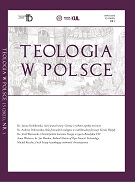Optyka światopoglądu chrześcijańskiego Summy Tomaszowej nadaje całej drugiej części neoplatońskiego schematu w niej zastosowanego cechę chrystoforyczności, z kolei całości dzieła teologicznego jednocześnie przydając inkarnacyjnej dynamiki. Gdy uwzględni się bowiem pojęcia o bardziej poglądowym zabarwieniu występujące we wszystkich prologach do poszczególnych części Summy, neoplatoński exitus-reditus można oddać w terminach z zakresu ascetyki: exemplarimago-via, gdzie człon pierwszy odpowiada rzeczywistości Boga jako wzorca, drugi rzeczywistości człowieka jako Bożego obrazu, a trzeci rzeczywistości Słowa wcielonego jako zaplanowanej drogi o kierunku Bóg-człowiek.
MEDIEVAL THEOLOGICAL SUMMAS AND THEIR STRUCTURE. GENOLOGICAL ANALYSIS OF “THE SUMMA THEOLOGICA” BY SAINT THOMAS AQUINAS.
Summary
This article is a part of M.A. thesis entitled “The Foundations of Aristotelianism as a Theological locus in The Summa Theologica by Saint Thomas Aquinas. The Ontological Analysis of the Union of the Incarnated Word.”. In this article the author tries to show that The Summa Theologica by Saint Thomas Aquinas was written according to an individual, original and well-considered structural idea. According to the author The Summa’s Christ and incarnation mystery centred worldview gives to Neoplatonic exitus-reditusscheme that was used in The Summa and other medieval theological compendiums (thanks to reditus per Christum) the Christophoric nature. In addition, it gives to the entirety of the Aquinas’ concept the incarnation and Christ centred dynamic.
“Did the Angelic Doctor Underestimate Christ?” examines the role of Christology in the thought of Thomas Aquinas. At the end of the Summa Theologica, Aquinas offers a discussion of the Incarnation in which he tends toward the view that Christ would not have taken human form had man not sinned. This position gives rise to the suspicion that the Dominican treated the Incarnation too lightly; that he understood it instrumentally, merely as a means to resolve the “problem” of sin. The author shows that the position accorded to the discussion of Christ in Aquinas’s work comes out of St. Thomas’ approach to Salvation History as a whole. The style of reasoning known as ex convenientia (“from suitability”), common among medieval theologians, permitted them to regard their interpretations of Salvation History as belonging to scientia in the Aristotelian sense while also allowing them to produce a balanced, two-sided analysis of every event. On the one hand, the Incarnation was deemed not absolutely necessary, since a transcendent God cannot be constrained by any one scenario. On the other hand, it was considered consistent with the logic of the divine design of love for Christ to have assumed a human nature. This bilateral analysis enabled theologians to admire the Incarnation as an act performed by God out of love, in freedom. The influence of G.F. Hegel’s metaphysics has caused the suggestion that the Incarnation was not absolutely necessary to appear suspect. Theologians inspired by the synthesis of the sage from Berlin tend to see the Incarnation as part of a necessary process. The metaphysical perspective they occupy – different from that of Aquinas – usually yields a distorted view of the medieval master. Yet St. Thomas’ approach to Salvation History, in which respect for God’s transcendence and appreciation for divine freedom
each have a place, remains the more interesting and well-balanced proposition and should have a prominent voice in contemporary discussions.
Ostatnia aktualizacja: 26.03.2012, godz. 00:19 - Natalia Haniewska































